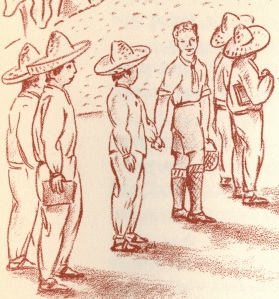Mexico and the United States: Migration, Politics, and Culture
Undergraduate Seminar, 4 credits
Spring 2018

Course Description
As we begin this seminar, renegotiations of the North American Free Trade Agreement are underway, new models for the border wall with Mexico are being tested, and Dreamers (a majority of whom were born in Mexico) are losing their hard-won legal status. In Mexico, public opinion has turned strongly against the United States in general and Donald Trump in particular. Diplomatic relations are particularly strained as Mexican leaders struggle to avoid antagonizing the United States without angering their own citizens.
But this tense moment has not distanced the two countries from each other in every arena. In the United States, consumers eagerly seek out Mexican food and drink, looking beyond Taco Bell and margaritas to try Oaxacan mole and mezcal. Mexico City has become a hot travel destination, and Frida Kahlo’s image can be found on shower curtains and mugs. In fact, despite the president’s anti-Mexico stance, a recent poll found that two-thirds of people in the United States view Mexico favorably. And as has been true for some time, Mexicans continue to buy U.S. products and travel to the United States for leisure and study even though the flow of labor migrants has slowed considerably.
Indeed, the political shifts of the past year have not unmade all of the many, deep connections between the two countries built over the past two centuries. Mexican migration to the United States is the most massive flow of immigrants in modern history. No country has more consulates in another country than Mexico has in the United States. Trade between these countries is crucial for both economies. The people of these two nations constantly share and adapt each other’s cuisine, music, language, and holidays. But despite proximity and interconnection, tension and violence are also near-constant features of interactions between the two countries. How has this peculiarly close, unequal, and ambivalent relationship developed between Mexico and the United States? By the end of this course, you will be able to offer some answers to this thorny question.
In this class, we will explore three interrelated dimensions of the bilateral relationship: migration, cultural exchange, and international politics. In addition to reading scholars’ accounts, you will examine primary sources during every class meeting. Over the course of the semester, you will work with newspaper articles, photographs, political cartoons, archival documents, children’s books, and other types of historical material. You will practice writing about and otherwise engaging with primary sources as you develop your final project. The format of that project is quite open, allowing you to engage with the methods and knowledge you’ll learn in this class in a way that suits your interests and strengths.
The course is divided into 4 units, spanning from nineteenth century to the present day, although the bulk of the course focuses on the twentieth century. We will cover periods of great tension between the countries, such as the Mexican-American War (1846-1848) and the Mexican Revolution (1910-1920), but we will also examine moments when friendlier relations prevailed. We will look at Mexican migration over the past 150 years. We will also note the intensity of cultural exchanges between the countries, particularly during the twentieth century, that have spanned from fine arts to fast food. Finally, we will talk about the economic ties that have long linked Mexico and the United States, including the 1994 signing of the North American Free Trade Agreement.
To explore some of the primary sources you will see in this class, click here.
For a syllabus, write to me: rgn2109@columbia.edu.
